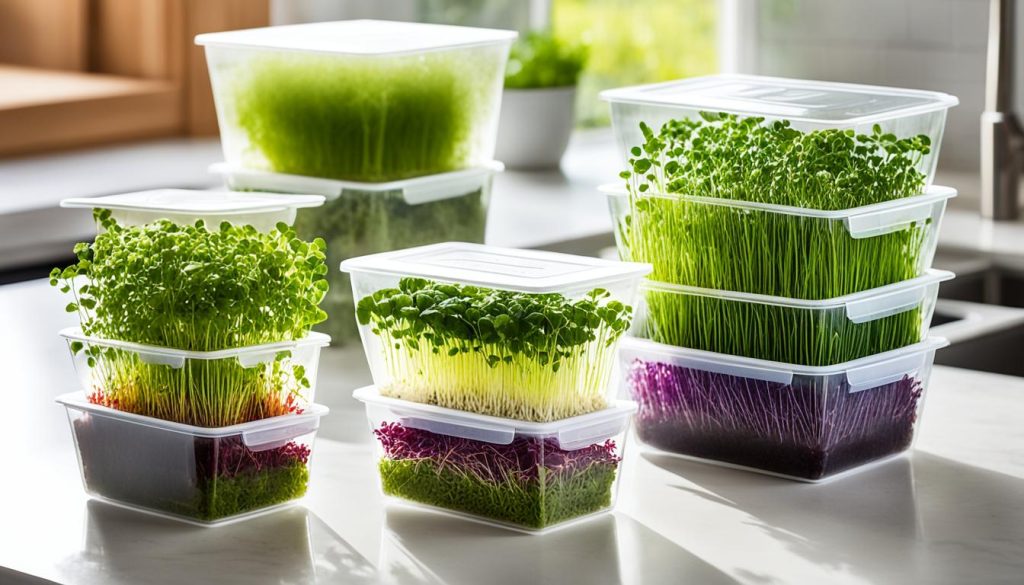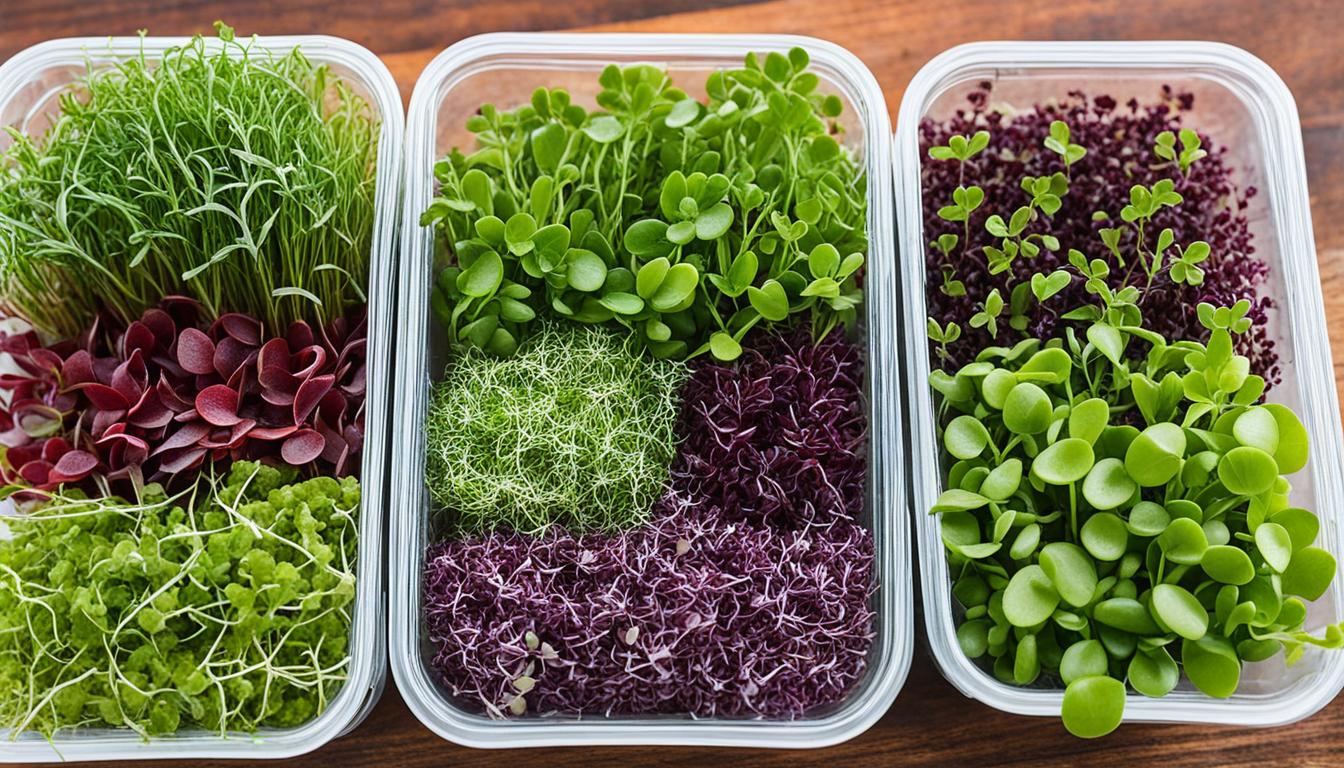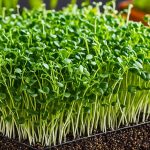Embracing the vibrant world of microgreens can be a delightful addition to your culinary repertoire. But with these lush, nutrient-dense greens comes a responsibility: knowing how to store microgreens efficiently. Savvy enthusiasts understand that proper storage of microgreens is not just about keeping food; it’s a matter of preserving vitality, taste, and the nutritious punch these tiny plants pack.
Whether you’re a green-thumbed gardener reaping your backyard bounty or an urban dweller picking up a pack at the local market, storing microgreens at home calls for a touch of know-how. To ensure that these diminutive greens stay as fresh as when they were first plucked, one must employ the best methods to store microgreens. Ready to keep your greens greener longer? Dive into our detailed guide bursting with microgreen storage tips designed to extend the life and flavor of your harvest.
Understanding Microgreen Freshness and Shelf Life
When considering the overall quality and edibility of microgreens, two factors stand out as critical: freshness and shelf life. These delicate greens are sought after not just for their piquant flavors and aesthetic appeal, but also for their substantial nutritional content. However, their fleeting freshness can pose a challenge for both cultivators and consumers.
Why Proper Storage Matters for Microgreens
Proper storage is the linchpin for preserving freshness of microgreens, keeping their sensory attributes and nutritive value intact. Neglect in this critical post-harvest phase can lead to rapid deterioration, negating the hard work put into growing them. Thus, employing effective tips for storing microgreens is imperative to delay spoilage and extend their vivacity on the plate. Ensuring that harvested microgreens are stored correctly also helps in reducing food waste, making storage methods both an economic and environmental consideration.
Expected Shelf Life of Various Microgreen Varieties
Each variety of microgreen comes with its own expected shelf life under optimal conditions. Pea shoots, with their robust structure, have a relatively long refrigerated shelf life, lasting upwards of three weeks. In contrast, tender selections such as mustards, arugula, and amaranth show a reduced endurance, remaining crisp up to ten days post-harvest. Common staples like broccoli, cabbage, and kale can be enjoyed for about 14 days when stored adeptly. Storing harvested microgreens in a manner tailored to their unique characteristics is essential for maximizing shelf life and keeping microgreens fresh.
Ultimately, the objective for any microgreen aficionado is not merely to extend shelf life but to maintain quality throughout that duration. A proactive approach to crop management, including growing in sync with consumption patterns, can significantly contribute to this end. Freshness is not just a state, but a continuum, where each day of extended life means another opportunity for these nutritional powerhouses to embellish our plates and palates.
Best Practices for Harvesting Microgreens
Harvesting microgreens properly is essential for storing microgreens for longer duration. To ensure peak freshness and flavor, it’s best to harvest these tender greens just before you plan to use them. This method reduces the time they spend in storage and maintains their crisp texture and vibrant color.
For some microgreens, such as SaiSai radishes and sunflower shoots, timing is everything. These varieties have a shorter peak window of perfection, making it crucial to harvest at the right moment. A precise cut, gentle handling, and immediate cooling are key factors in prolonging shelf life and ensuring the microgreens retain their nutritional density and rich taste.
If your culinary creation isn’t imminent, make sure to cut with care, aiming to minimize damage to the plants and their roots. Cooler temperatures slow down metabolic processes, helping to preserve the microgreens in a state of suspended freshness until they reach your plate. Remember, gentle and minimal handling is the cornerstone of longevity for these delicate greens.
Mindful harvesting contributes significantly to the longevity of microgreens. Implementing these best practices is not just about savoring flavor; it’s about embracing a sustainable approach to our food resources. By harvesting only as needed, we can all play a part in reducing food waste while enjoying the fresh harvest that microgreens offer.
Key Factors That Affect Microgreen Freshness
When it comes to storing microgreens at home, understanding how to maintain their delicate freshness is essential. Within this intricate balance, moisture plays a paramount role. Both too much and too little can have adverse effects, making the control of internal and external moisture critical to microgreen longevity. Additionally, timing your harvest right can mean the difference between a crisp, flavorful green and one that’s past its prime.
The Importance of Internal and External Moisture Control
For those with a green thumb, the juiciness and vibrancy of your microgreens are closely tied to their internal moisture content. Simultaneously, excess external moisture is a harbinger for mold and bacteria – unwelcome guests in any microgreen storage setting. This intricate dance of hydration necessitates not just keen attention but also expert microgreen storage tips to keep these minuscule greens at their peak.
Optimal Harvesting Time to Retain Freshness
Proper timing plays a crucial role in the post-harvest life of your microgreens. Taking into account the variety and your culinary plans, aim to harvest close to the point of consumption. This practice aligns perfectly with the ethos of microgreen enthusiasts who value peak freshness and flavor. Making this strategic cut with a sharp knife fosters minimal damage to the stems, thereby significantly slowing down the oxidation process. It’s these small, yet impactful, steps that contribute to preserving the alluring qualities of microgreens.
How to Store Microgreens: Preventing Moisture-Related Issues
When it comes to storing microgreens at home, the key challenge most enthusiasts face is managing moisture to avoid premature spoilage. As tempting as it might be to immediately tuck away your fresh greens, taking the right steps to ensure they’re dry can significantly extend their freshness and usability. Let’s delve into why moisture is not a friend to your delicate harvest and how you can effectively combat it.
Why Wetness is the Enemy of Stored Microgreens
Microgreens are packed with nutrients and flavor, but they are also incredibly sensitive to their environment. Excessive dampness can turn a container of sprightly greens into a slimy mess in no time. The presence of moisture can prompt the growth of mold and bacteria, leading to decomposition. Therefore, how to store microgreens correctly hinges on keeping them as dry as possible after harvest and during storage.

The Role of Absorbent Materials in Storage
The use of absorbent materials is a practical solution for proper storage of microgreens. Including a dry paper towel at the bottom of your storage container can work wonders by soaking up any residual moisture, keeping your microgreens dry and extending their shelf life. It’s especially important for water-retentive varieties, like radish microgreens, which are more susceptible to holding moisture. By ensuring these greens are thoroughly dried before they’re stored, you not only prevent spoilage but also maintain the crisp, fresh quality that makes your home-grown microgreens so delightful.
Choosing the Right Container for Microgreens Storage
For those invested in keeping microgreens fresh, selecting the perfect storage vessel is as crucial as the cultivation process itself. The balance between material composition and functional design is key to extending the vitality of these leafy greens.
The Debate: Plastic vs. Glass Containers
Plastic containers are favoured in the market for their lightweight and durable nature. They’re also non-porous, which prevents the absorption of moisture and odors. However, the sustainability of glass makes it an equally attractive option. Glass does not leach chemicals and is easier to sanitize, which can be significant for microgreen storage tips that highlight long-term health effects and flavor purity.
How Airflow Affects Microgreens in Storage
Adequate airflow plays a pivotal role in averting condensation and maintaining a suitable humidity level inside the container. A slight opening or a container made with breathable material could be the best methods to store microgreens, allowing the necessary exchange of gases without drying them out. Achieving this delicate balance is essential for prolonging the freshness of these nutritious, aromatic greens.
Precise Cutting Techniques for Longer Lasting Microgreens
Meticulous harvesting is an art that contributes significantly to the preservation of your greens. When it comes to storing harvested microgreens, the cut used during harvest is not just a trivial step; it’s a crucial one. A sharp knife is your best ally in this endeavor, as it ensures a precise and clean cut without harming the delicate structures of the plants. This technique is paramount in extending the life of your greens once they’re stored, and at the same time, keeping them vibrant and nutritious.
Why a Sharp Knife Makes a Difference
The secret to storing microgreens effectively begins well before they reach the container. A sharp knife offers a clean slice through the stem, which minimizes damage and provides a better chance at longevity for each sprout. Dull blades or improper cutting tools can crush or tear the stems, leading to a hastened degradation that can severely impact shelf life and freshness.
How Bruising Accelerates Decomposition
One of the vital tips for storing microgreens is to minimize any bruising during the cutting process. Bruises on plants are much like wounds that lead to faster decay due to the exposure of inner tissues to bacteria and oxidation. Gentle handling and the use of proper techniques when harvesting are therefore indispensable steps to ensure the vitality of your microgreens for as long as possible.
Storing Microgreens Without Washing: Understanding the Risks and Benefits
The intricacies of proper storage of microgreens often lead to a preference for keeping them unwashed until right before they are set to be consumed. This strategic approach plays a significant role in preserving freshness of microgreens, while also mitigating the potential for spoilage. To navigate this delicate balance, it is helpful to acquaint oneself with a few practices that optimize longevity and nutritional value.
When to Wash Microgreens to Maintain Freshness
In the realm of microgreen storage, timing is key. The act of washing these fragile plants not only removes remnants of soil or debris but also enhances their palatability. However, introducing them to water too soon after harvesting can create a hospitable environment for bacteria, which accelerates decomposition. Consequently, it’s recommended to wash microgreens only moments before they are destined to uplift a meal with their vibrant taste and texture.
Reducing the Risk of Bacterial Contamination
Maintaining the integrity of stored microgreens extends beyond the avoidance of premature washing. It encompasses gentle handling during both harvest and subsequent storage, ensuring that any form of physical stress—which might invite bacterial growth—is kept at bay. Additionally, being mindful not to overcrowd storage containers can prevent excess moisture accumulation, consequently mitigating the risk of contamination and extending the shelf life of these nutrient-dense greens.
The Best Temperature Range for Microgreen Preservation
Microgreens, with their delicate structures and high nutrient content, necessitate careful preservation to maintain their quality and extend shelf life. Discerning the best methods to store microgreens involves not just selecting the right containers and ensuring proper dryness, but also maintaining the correct temperature. The optimum temperature range to keep these greens fresh and retain their vibrancy is a cool 35-40° F. This cold environment is not by accident; it slows down the respiration rate of the microgreens, helping to store them for a longer duration without compromising their crispness or flavor.
Adjusting Refrigerator Settings for Optimal Conditions
Refrigerators can fluctuate in temperature, so it’s essential to adjust the settings to create an environment that’s ideal for microgreens. Keep them away from the coldest areas to prevent freezing, and monitor the refrigerator’s interior with a reliable thermometer to ensure the temperature stays within the desired range. Storing microgreens at consistent temperatures helps thwart the premature decay and sustains its nutritional value. Additionally, remember to check the humidity level in your refrigerator, as excess moisture can be just as damaging as incorrect temperatures.
Identifying the Signs of Spoiling Due to Incorrect Temperatures
To maximize the benefits of properly stored microgreens, spotting the early signs of spoilage is crucial. If the temperature is too high, microgreens may start to wilt or yellow, while cold damage may cause them to become limp or develop ice crystals. A pungent smell or slimy texture is a clear indication that your greens have gone past their prime, and consumption should be avoided to prevent potential food-borne illnesses. Regular inspection will not only help in identifying these signs early but also in making the necessary adjustments to prolong their freshness.
FAQ
What is the best method to store microgreens?
The best method to store microgreens involves keeping them dry and chilled. Store them in a clean, airtight container lined with a paper towel to absorb moisture, in the refrigerator at a temperature between 35-40° F. Do not wash them until ready for use to avoid additional moisture.
How long can I expect my microgreens to stay fresh?
The shelf life of microgreens varies by variety. Pea shoots can last over three weeks, while soft microgreens like mustards and amaranth may last up to ten days. More common varieties like broccoli, cabbage, and kale can stay fresh for up to 14 days when stored properly.
Why is controlling internal and external moisture important when storing microgreens?
Balancing internal and external moisture is crucial for prolonging the fresh state of microgreens. Internal moisture keeps them juicy and plump, while controlling external moisture is necessary to prevent mold and bacterial growth. Excessive moisture can create an environment for spoilage.
Should I use plastic or glass containers for storing my microgreens?
Both plastic and glass containers can be used for storing microgreens, provided they offer adequate airflow and can be sealed properly. Glass is less prone to retaining odors or stains and can offer clearer visibility of the microgreens’ condition, while plastic is more lightweight and often more convenient.
How does the way I cut microgreens affect their shelf life?
A clean, straight cut made with a sharp knife causes less damage to the microgreens’ cells, which can slow down decomposition and maintain freshness. Scissors might bruise the greens, causing faster spoilage due to increased cell damage.
Can I wash microgreens before storing them?
It is best to store microgreens unwashed to prevent introducing excess moisture that can lead to faster degradation. To maintain freshness, wash them just prior to use.
What are the signs that microgreens are no longer fresh and should not be consumed?
Signs of spoiling include a sour or musty smell, sliminess, discoloration, and a significant decrease in their firmness and crisp texture. If you notice any of these changes, it is best to discard the affected microgreens to avoid the risk of consuming spoiled or contaminated produce.
Why is it recommended not to harvest all the microgreens at once?
Harvesting only as needed ensures that the microgreens remain living and continue to retain their maximum freshness and nutritional value. When you cut the entire tray, the greens can no longer draw nutrients from their root system, which can hasten deterioration.
How can I tell if my refrigerator is set to the right temperature for storing microgreens?
A refrigerator thermometer can help you monitor the internal temperature, which should be set at or below 35-40° F for optimal microgreen preservation. Consistently maintaining this temperature range is key to extending their shelf life.
What should I do if my microgreens get wet during storage?
If microgreens become wet, spread them out on paper towels to dry thoroughly before placing them back in the storage container. Always ensure they’re dry before returning them to the refrigerator to avoid potential mold and spoilage.


